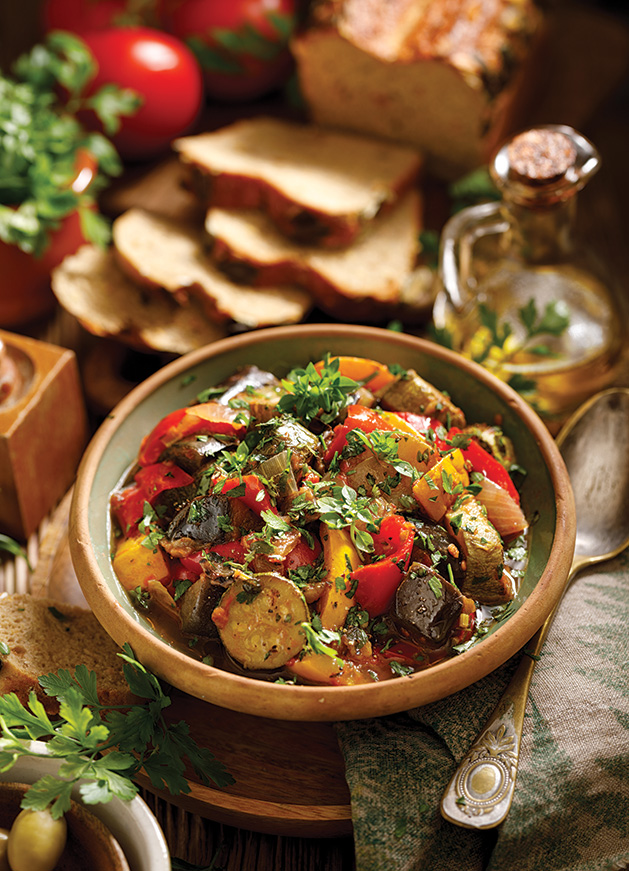
Mahtomedi resident Lee Wolfson is a retired architect turned enthusiastic home cook and baker. Wolfson became interested in food about 20 years ago, and credits his ex-wife for much of his cooking knowledge.
He takes a straightforward approach to cooking and isn’t afraid to make mistakes along the way. “I do it, and I do it, and I do it, until I figure it out,” he says. Pizza is one of Wolfson’s favorites. He makes his own crust, using 00 flour (Italian-style—very finely-milled) using a New York Times “quick crust” recipe. Wolfson says the key is freezing the dough overnight, which produces a more intense wheat taste. Some of Wolfson’s favorite toppings are sautéed portobello mushrooms and a mix of yellow and red peppers. For the cheese, he’s a devotee of Kowalski’s handmade fresh mozzarella.
Wolfson’s favorite cookbook? “I’m almost embarrassed to admit it, but Joy of Cooking, he says. Why is he embarrassed? “Well, it’s so middle of the road. It is a fine cookbook for all the standard American fare. I just think that tastes have changed and become more sophisticated along with the diversity of the country,” Wolfson says.
Wolfson notes that Irma Romabauer, the author of Joy of Cooking, never tried most of the recipes in the book—she just compiled them. “I remember Meryl Streep’s [playing Julia Child in the movie Julie and Julia] expression of subtle disgust when Rombauer casually dismisses the idea that she actually tried all those recipes,” he says.
Moosewood Cookbook is another book Wolfson often uses, although his connection to the book could be described as a love-hate relationship. “It kind of makes me cringe,” he says. “Moosewood Cookbook reminds me of the culture and rhetoric of the ’70s. The amateurish hand lettering and illustrations go well with the faded, moth-eaten photos of the author and the restaurant. It reminds me of the extremely dense whole-wheat muffins and undercooked vegetables of the period. That grubby hippy-ness is an indelible part of what is actually a pretty good cookbook.” Wolfson says, then he makes a disclaimer. “These opinions reflect only my feelings on the matter and [his wife] Carol is less put off about the feel of Moosewood and is constantly proving me wrong about the quality of the recipes.”
Wolfson isn’t the only creative person in the household. His wife Carol, who taught art for 30 years, had the goal of retiring at 62 to be able to pursue her art—pottery. Carol met her goal and has been working seriously in her backyard studio—outfitted with a potter’s wheel and kiln. She sells some of her work at area farmers markets and art fairs.
Lee and Carol’s son Leo Wolfson, now a reporter in Cody, Wyoming, recently traveled to Morocco where he worked in a hostel and learned to cook Moroccan cuisine to feed the hostel’s guests. The most common dish in Morocco, he says, is tagine. Tagine is a stew with origins in North Africa. It’s named after the clay pot that it’s cooked in. These funnel-shaped pots can range from simple clay vessels to elaborately decorated works of art. Tagine is a meal-in-a pot with endless possible variations. Often, says Wolfson, meat is the central ingredient. “A lot of times it’s lamb or beef. It can be chicken, too. But you can do it vegetarian or vegan too and it’s great,” Leo says.
Spices, says Wolfson, are key. The fresher the better. “In Morocco, we were usually handed packets of fresh spices to throw into the tagine. I never knew what was in them. Definitely turmeric and cinnamon, though, and coriander,” he says.
As is common in restaurant kitchens throughout the world, ingredients are not measured, but added with the skill of a practiced eye. For those of us who need recipes, try Allrecipes’ recipe for lamb tagine. For vegetarians, try the BBC food website’s highly rated vegetarian tagine with almond and chickpea couscous.
The beautiful tagine pots are inspiration in themselves to try it.
Bsaha! (Cheers, or bon appetit, in the Darija dialect of Morocco.)
Food Notes
Essential ingredients in Moroccan cooking:
Chickpeas are a great vegan source of protein.
Dried fruits add a touch of sweetness and can be a rich source of vitamins, including iron and potassium. Dried apricots are rich in Vitamin A.
Turmeric, high in antioxidants, is believed to have anti-inflammatory properties. Imparts a rich golden color.
Spiced vegetable tagine (from BBC Food)

Photo courtesy of istock.com
Ingredients
- 1 sweet potato (about 10½ oz.), peeled and cut into ¾ inch chunks
- 1 eggplant, cut into 1 inch chunks
- 2 zucchini, halved lengthways, sliced into ¾ inch half-moons
- 1 red pepper, stalk and seeds removed, cut into 1 inch chunks
- 3 Tbsp. mild olive oil or sunflower oil
- 1 small onion, thinly sliced
- 4 garlic cloves, thinly sliced
- 1 tsp. ground coriander
- 1 tsp, ground cumin
- 14-oz. can chopped tomatoes
- 1 Tbsp. harissa paste
- 2 tablespoons honey
- 3½ oz. dried apricots, halved
- 14-oz. can chickpeas, rinsed and drained
- Handful chopped fresh coriander, to garnish
- Salt and freshly ground black pepper
Directions
1. Preheat the oven to 375 F.
2. Mix sweet potato, eggplant, zucchini and red pepper in a large bowl. Drizzle 2 Tbsp. of the oil over and mix to coat. Season generously with salt and pepper.
3. Heat a large, non-stick frying pan over high heat. When hot, add the vegetables in batches and fry, stirring regularly, for 3–4 minutes, or until lightly browned.
4. Heat remaining oil in a heavy covered pot over medium heat. Add onions and fry for 3–5 minutes, stirring regularly, until softened. Add garlic, coriander and cumin and fry for 1–2 minutes, stirring frequently.
5. Stir in tomatoes, harissa paste, honey, apricots and chickpeas until well combined. Add the vegetables and cook for 2–3 minutes.
6/ Cover and transfer to oven. Cook for 30 minutes, then stir in 7 oz. cold water until well combined. Return to the oven, covered, for 15 minutes, or until thick and the vegetables are tender.
7. Sprinkle with chopped coriander. Serve with freshly cooked couscous or rice.









